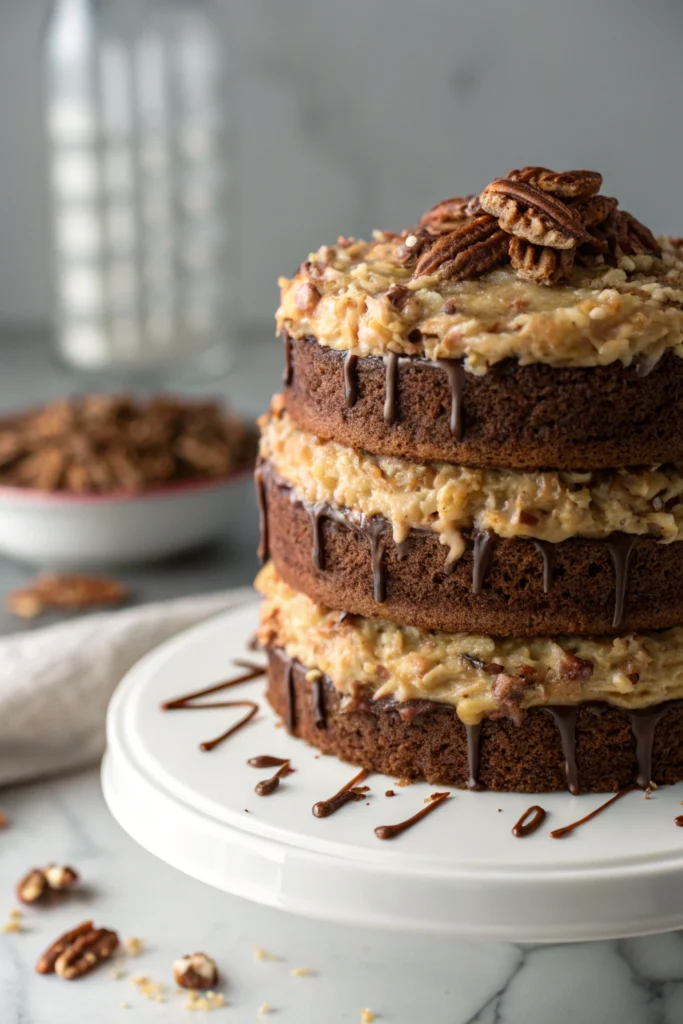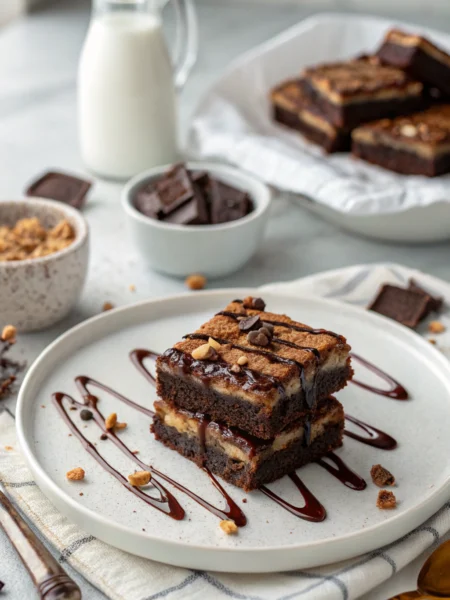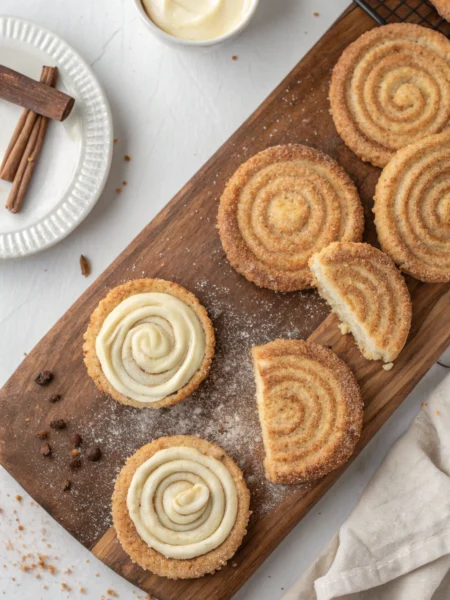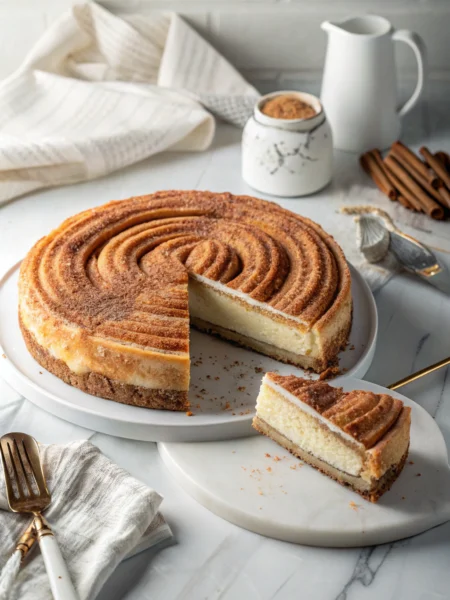Ready to master the most heavenly German chocolate cake recipe you’ll ever taste? This triple-layer stunner combines rich chocolate layers with that classic coconut-pecan frosting we all crave. I’ve been perfecting this recipe for years in my family’s bakery, and trust me – it’s absolutely foolproof!
The secret? We’re using buttermilk and melted chocolate to create incredibly moist cake layers that practically melt in your mouth. Plus, I’ll show you my grandmother’s special trick for getting that frosting just right. Whether you’re baking for a special occasion or just craving something decadent, this cake never disappoints.
Why German Chocolate Cake Stands Apart ?
Origins of German's Sweet Chocolate
Did you know that German chocolate cake actually isn’t German at all? This beloved recipe gets its name from Samuel German, an American baker who created a special dark baking chocolate for Baker’s Chocolate Company in 1852. The original chocolate had a higher sugar content than traditional baking chocolate, making it perfect for creating this iconic cake.
The recipe itself didn’t become famous until 1957, when a Dallas newspaper published a reader’s recipe for “German’s Chocolate Cake.” The cake became such a hit that Baker’s Chocolate started printing the recipe on their chocolate bars!
Fun fact: the apostrophe and ‘s’ eventually dropped off, leading many to mistakenly think this cake originated in Germany. Today, this sweet treat remains a staple at American celebrations, beloved for its unique combination of chocolate intensity and tropical coconut-pecan goodness.
Traditional Recipe Components
A classic German chocolate cake recipe combines three essential elements that create its signature taste. The foundation starts with a moist chocolate cake made from German’s sweet baking chocolate, though modern versions often use a mix of cocoa powder and semi-sweet chocolate.
The star of the show is definitely the coconut-pecan frosting, which sets this cake apart from other chocolate desserts. You’ll need fresh egg yolks, evaporated milk, butter, sugar, shredded coconut, and chopped pecans to create this gooey, caramel-like topping. Unlike most layer cakes that use frosting on the sides, this beauty traditionally only features the coconut-pecan mixture between layers and on top.
The cake layers themselves strike a perfect balance – they’re rich enough to complement the sweet frosting but not so intense that they overwhelm your taste buds.
Signature Coconut-Pecan Frosting Benefits
Making a German chocolate cake recipe becomes truly rewarding when you master its iconic frosting. This heavenly topping doesn’t just taste amazing – it actually gets better with time! The coconut and pecans slowly absorb the caramel-like base, creating deeper flavors after 24 hours. Plus, this frosting stays fresh longer than traditional buttercream, lasting up to five days in the fridge.
You’ll love how it doesn’t melt at room temperature, making it perfect for outdoor gatherings. The frosting’s thick texture also helps hold cake layers firmly in place, preventing any sliding that often happens with smoother frostings.
For the best results, toast your pecans beforehand to bring out their nutty flavor, and use fresh coconut when possible. Remember to cool the frosting completely before spreading – it’ll thicken naturally and become easier to work with.
Perfect German Chocolate Cake Step-by-Step
Ingredient Preparation & Measurements
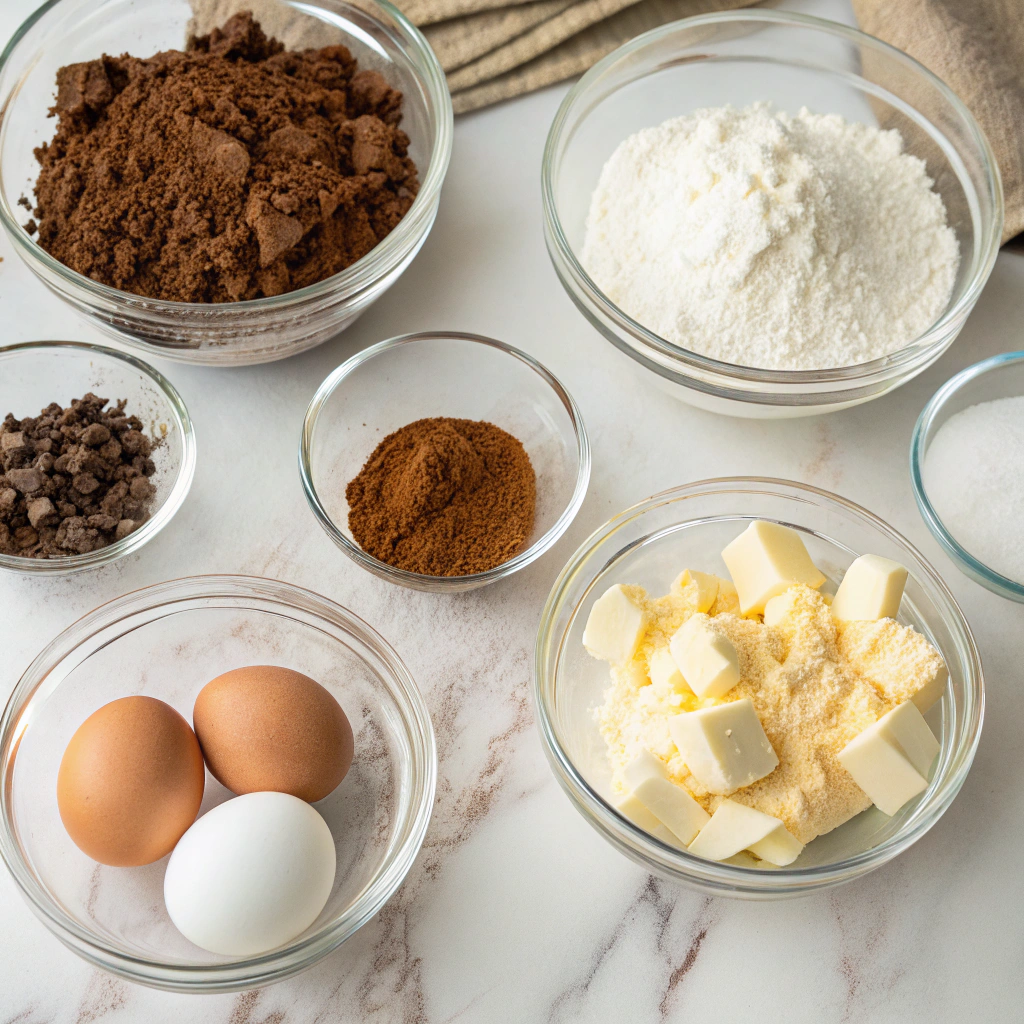
Before diving into this decadent german chocolate cake recipe, proper mise en place is crucial for success. Start by bringing all refrigerated ingredients to room temperature – this typically takes about 30 minutes. The eggs, buttermilk, and butter must be perfectly tempered for the smoothest batter. While waiting, measure your dry ingredients precisely using the spoon-and-level method. Sift the cocoa powder and flour together to eliminate any lumps that could create dry spots in your cake.
For the signature chocolate flavor, choose high-quality German sweet chocolate – it has a higher sugar content than semi-sweet, giving this cake its characteristic mild, sweet taste. Pre-greasing your cake pans with butter and lining them with parchment paper now will save you stress later. Remember to position your oven rack in the center position for even baking.
Mastering the Perfect Cake Layers
Creating flawless layers is crucial for this german chocolate cake recipe. Start by dividing your batter evenly between three 9-inch cake pans – using a kitchen scale helps achieve perfect uniformity. The key is filling each pan only two-thirds full to allow proper rise. As the layers bake, you’ll notice a heavenly chocolate aroma filling your kitchen.
Watch for the telltale signs of doneness: the cake should spring back when lightly pressed, and a toothpick inserted in the center should come out clean with just a few moist crumbs. The edges will start to pull away slightly from the pan sides. Let the layers cool in their pans for exactly 10 minutes – any longer risks condensation forming.
Then carefully turn them out onto wire racks to cool completely. This patience-testing step is non-negotiable for preventing layers from breaking or sticking.
Mastering the Chocolate Coconut Frosting
For this german chocolate cake recipe, the frosting is where tradition meets indulgence. Start by toasting coconut flakes until golden brown – they’ll fill your kitchen with an irresistible nutty aroma. In a heavy saucepan, combine evaporated milk, sugar, egg yolks, and butter, stirring constantly over medium heat.
Watch as the mixture thickens like magic, usually taking about 12 minutes. The key is patience – rush this step and you’ll end up with scrambled eggs instead of silky frosting! Once it coats the back of a spoon, remove from heat and fold in those toasted coconut flakes and chopped pecans.
Let it cool completely before spreading between your cake layers. The frosting should be thick enough to hold its shape but still spreadable. This classic combination creates that signature sweet-nutty flavor that makes German chocolate cake so unforgettable.
Pro Tips for German Chocolate Success
Temperature Control Secrets
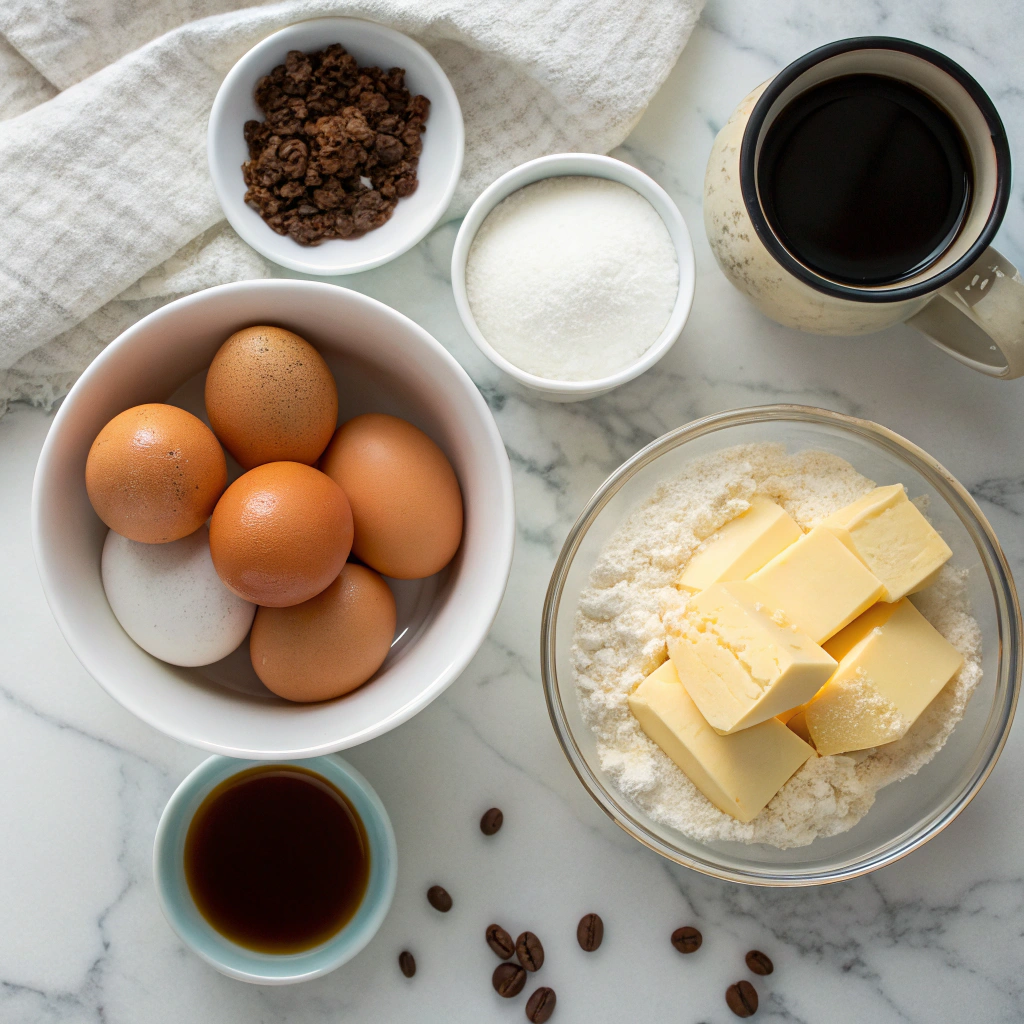
Creating the perfect german chocolate cake recipe starts with mastering temperature control. Every ingredient should be at room temperature before you begin – this includes eggs, butter, and even that cup of coffee you’ll add for depth. Cold ingredients can cause your batter to curdle or become lumpy. Let butter soften naturally for 1-2 hours; never microwave it! For eggs, place them in warm (not hot) water for 5-10 minutes.
Your cake layers will thank you with even rising and a perfectly moist crumb. The oven temperature is equally crucial – invest in an oven thermometer, as many ovens run hot or cold. Bake at exactly 350°F (175°C) for consistent results.
Remember, rushing this step leads to uneven baking and potential disasters. When testing doneness, your toothpick should come out with just a few moist crumbs.
Frosting Secrets for German Chocolate Success
Making the perfect german chocolate cake recipe requires mastering that signature coconut-pecan frosting. Start with toasted pecans – the nutty aroma tells you they’re ready! Combine evaporated milk, sugar, and egg yolks in a heavy saucepan, stirring constantly over medium heat until bubbling and thickened. Watch for that magical moment when it coats the back of your spoon!
Once thickened, fold in butter, toasted pecans, and coconut. The mixture should be spreadable but not runny. Let it cool completely before frosting – rushing this step can ruin your cake layers.
For picture-perfect results, use an offset spatula to create swooping patterns between layers. Remember to leave some frosting cascading down the sides – that rustic look is part of this cake’s charm! Store any leftover frosting in an airtight container for up to 3 days.
Baking Pan Prep: Essential Steps for German Chocolate Success
A perfect german chocolate cake recipe starts with proper pan preparation. Line three 9-inch round cake pans with parchment circles, then grease and flour the sides generously. This extra step prevents sticking and ensures clean release every time. Dark, non-stick pans work best – they help develop that rich, golden-brown crust we’re after.
If you only have light-colored pans, no worries! Just add 2-3 minutes to your bake time. For extra insurance against sticking, dust your greased pans with cocoa powder instead of flour. This trick maintains that deep chocolate color throughout. Make sure your pans are at least 2 inches deep to prevent overflow.
And here’s a pro tip: tap each filled pan firmly on the counter several times to release any trapped air bubbles. This simple step helps create those perfectly even layers that make your cake both beautiful and professional-looking.
Fixing Common German Chocolate Issues
Preventing Cake Layer Collapse
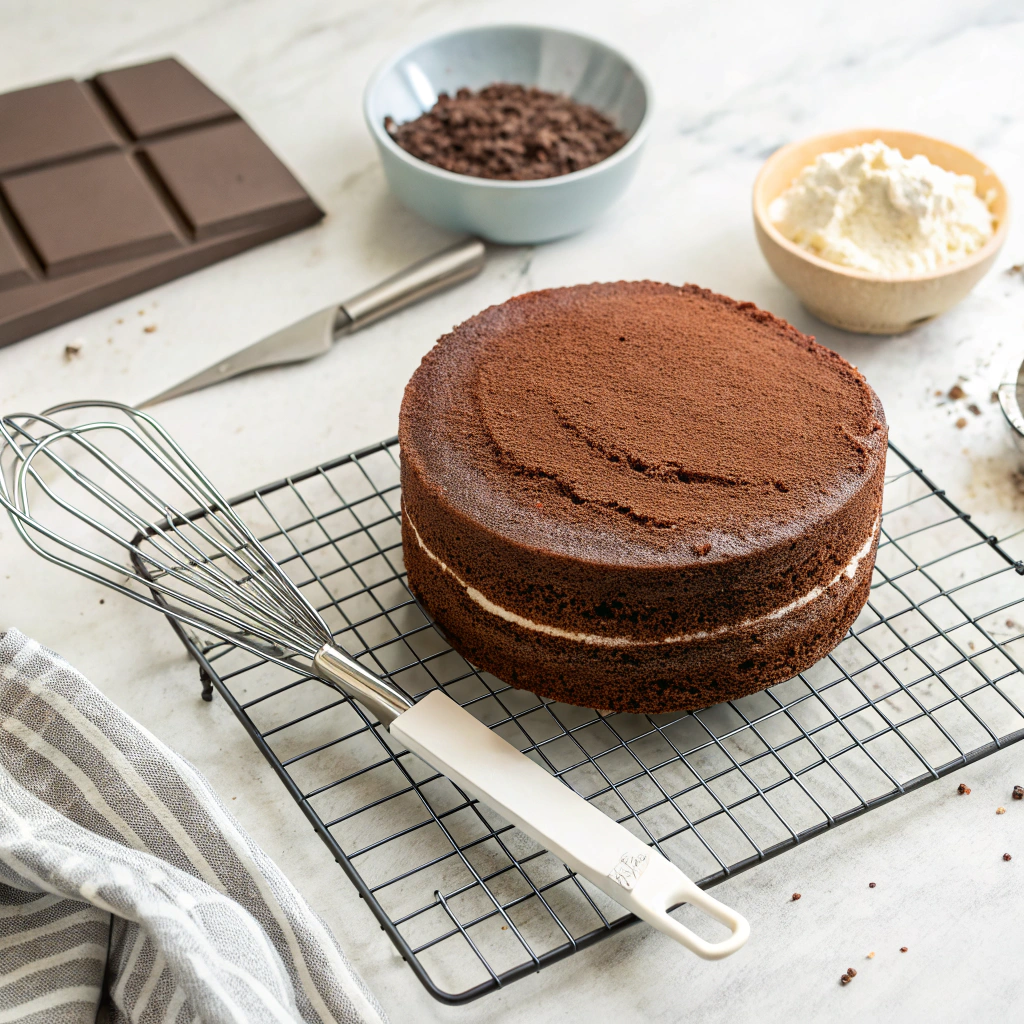
Creating a stable german chocolate cake recipe starts with proper mixing technique. Beat your butter and sugar until truly light and fluffy – this takes about 5-7 minutes, no shortcuts! When adding eggs, incorporate them one at a time at room temperature. This prevents the dreaded curdled look that can lead to dense, fallen layers.
Fold in your dry ingredients gently but thoroughly, scraping the bottom of the bowl frequently. Over-mixing at this stage activates too much gluten, making your layers sink. Watch your oven temperature carefully – a too-hot oven causes rapid rising followed by dramatic collapse. Test with an oven thermometer and adjust accordingly.
And resist the urge to peek while baking! Each oven door opening drops the temperature by 25-50 degrees, disrupting the delicate rising process. Let your cake cool in the pan for exactly 10 minutes before turning out.
Perfecting Your German Chocolate Frosting
Creating the signature coconut-pecan frosting for your german chocolate cake recipe requires careful attention to detail. Start by gently toasting your pecans until they release their oils and become fragrant – about 5-7 minutes at 350°F. Meanwhile, combine egg yolks, evaporated milk, and sugar in a heavy-bottomed saucepan. Cook over medium heat, stirring constantly, until the mixture thickens and coats the back of a spoon. This takes patience – rushing leads to scrambled eggs!
Once thickened, remove from heat and stir in butter until melted. Finally, fold in your toasted pecans and coconut while the mixture is still warm. Let it cool completely before spreading, as this allows the frosting to set properly and develop that classic fudgy texture.
The frosting should be spreadable but thick enough to hold its shape when layered.
Mastering the Perfect German Chocolate Cake Layers
Creating tender, moist cake layers is crucial for your german chocolate cake recipe success. Start by bringing all ingredients to room temperature – this helps achieve that perfectly smooth batter. When mixing, cream your butter and sugar until light and fluffy, about 3-4 minutes. Don’t rush this step! Add eggs one at a time, beating well after each addition.
For the dry ingredients, whisk them separately before incorporating to ensure even distribution. The key is alternating wet and dry ingredients while mixing on low speed – this prevents overmixing and tough cake layers. Pour equal amounts of batter into your prepared pans, gently tap them on the counter to remove air bubbles, and bake until a toothpick comes out clean.
Let cool in pans for 10 minutes before turning out onto wire racks. This patience ensures your layers won’t crack or stick.
Creative German Chocolate Variations
Classic Three-Layer Design
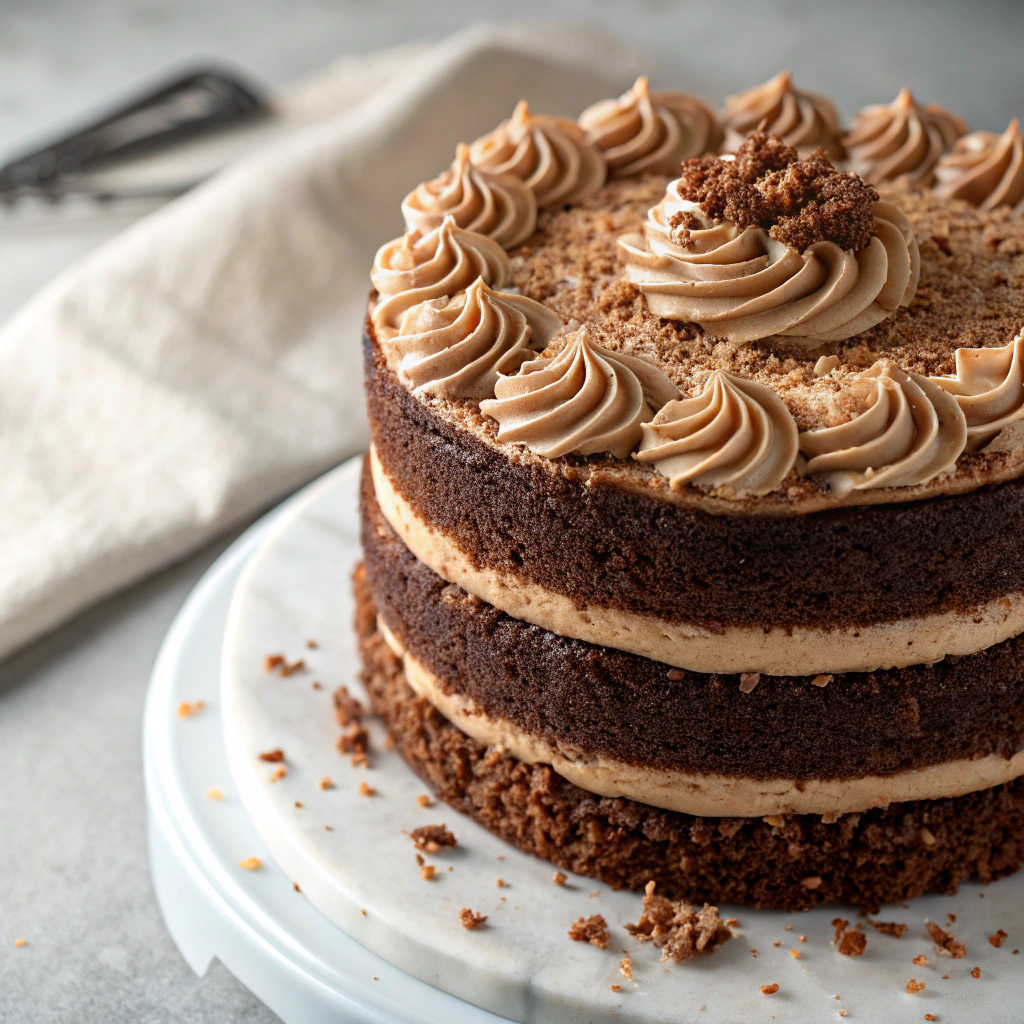
Creating the perfect three-layer german chocolate cake recipe starts with proper assembly. Begin by leveling each cooled cake layer using a serrated knife – this ensures even stacking and professional presentation. Place your first layer on a cake board and spread a generous amount of that signature coconut-pecan frosting, letting it slightly overhang the edges. The key is maintaining consistent frosting thickness between layers – about 1/4 inch works perfectly.
As you stack each layer, press down gently to secure while keeping everything centered. For the final layer, create an eye-catching swirl pattern with the frosting on top, leaving the sides naked to showcase those beautiful layers.
This rustic-yet-elegant style has become increasingly popular, allowing the cake’s rich, dark color to contrast beautifully with the golden-brown frosting.
Modern Frosting Techniques
When creating a german chocolate cake recipe, mastering modern frosting techniques adds professional flair. Try the trendy drip effect by warming the coconut-pecan mixture slightly and carefully pouring it near the edge, allowing gravity to create artistic drips. Another popular approach is the semi-naked look – apply a thin scrape of frosting on the sides while letting hints of cake peek through.
For texture interest, use a large offset spatula to create elegant horizontal strokes around the sides, or try the rustic swoops technique on top using the back of a spoon. Some bakers are even incorporating metallic elements by painting small sections of the coconut pieces with edible gold dust.
Remember to chill your cake between frosting applications for cleaner lines. These contemporary techniques transform the traditional german chocolate cake into an Instagram-worthy masterpiece while maintaining its classic charm.
Baking Tips for Perfect Results
A successful german chocolate cake recipe starts with mastering essential baking fundamentals. Always bring ingredients to room temperature before starting – cold eggs or butter can affect the cake’s texture. For the richest chocolate flavor, bloom your cocoa powder by whisking it with hot water before adding to the batter. When measuring flour, use the spoon-and-level method rather than scooping directly with the measuring cup, which can pack too much flour and lead to a dense cake.
Mix wet and dry ingredients just until combined to avoid developing too much gluten. Test for doneness by inserting a toothpick in the center – it should come out with a few moist crumbs, not completely clean. Let layers cool completely in the pans for 10 minutes before turning out onto wire racks.
These simple but crucial steps ensure your german chocolate cake turns out perfectly moist and tender every time.
Start Baking Your Perfect Cake Today
Ready to create your own masterpiece? This German chocolate cake recipe combines rich tradition with foolproof techniques. Gather your ingredients, preheat that oven, and get ready to bake something truly special. Your kitchen will soon be filled with the irresistible aroma of chocolate, toasted pecans, and sweet coconut. Share the joy – this cake makes every occasion memorable!
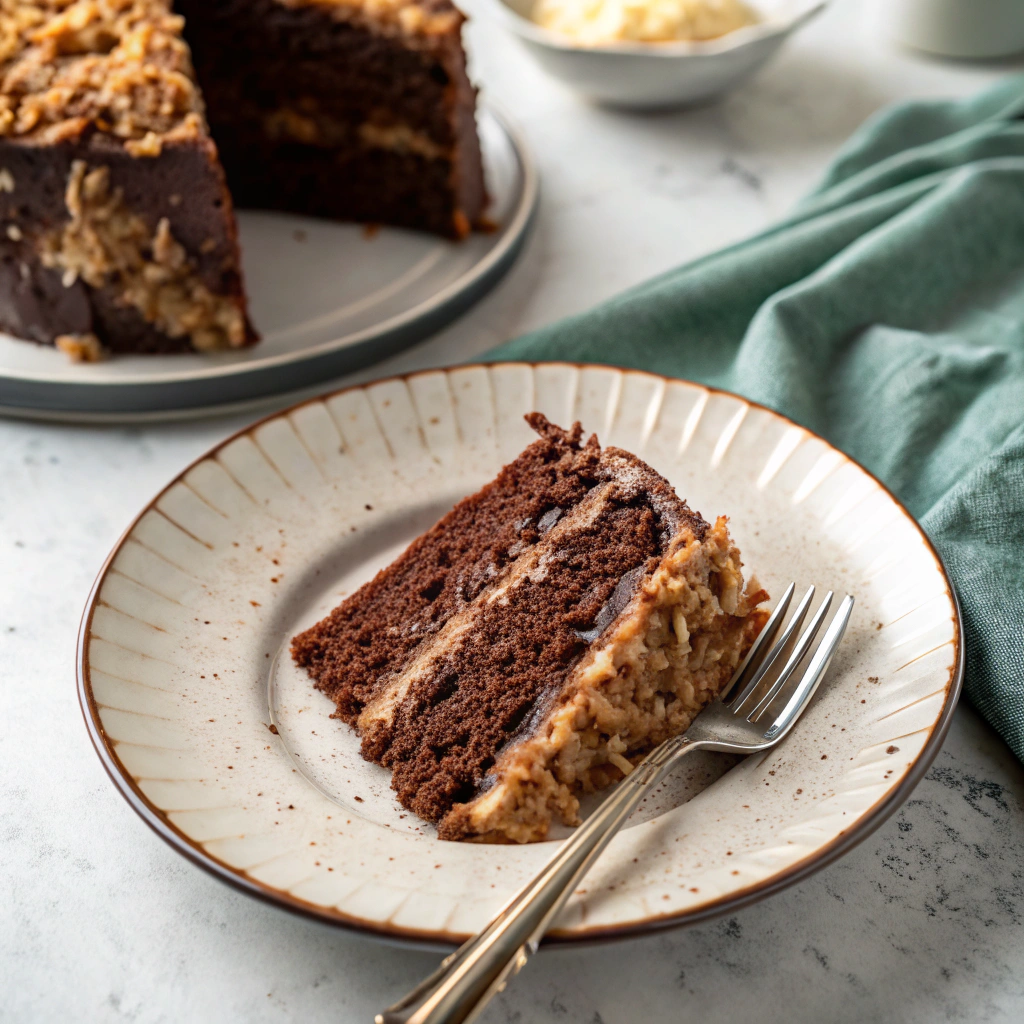
German Chocolate Cake Recipe
A rich, moist chocolate cake featuring three perfectly stacked layers crowned with traditional coconut-pecan frosting. This homemade version of the American classic combines sweet German's chocolate with buttermilk for an irresistibly tender crumb.
Ingredients
Cake Layers:
Coconut-Pecan Frosting:
Instructions
Cake Preparation:
- Preheat oven to 350°F
- Grease three 9-inch cake pans, line with parchment
- Melt chocolate with hot water, stir until smoothMixture should be completely smooth with no lumps
- Whisk flour, baking soda, and salt
- Cream butter and sugar until light and fluffy5-7 minutes
- Add eggs one at a time, beating well after each
- Mix in melted chocolate and vanilla
- Alternate adding flour mixture and buttermilk, starting and ending with flourMix just until combined
Baking:
- Divide batter evenly between pans
- Bake 25-30 minutesToothpick inserted in center should come out with few moist crumbs
- Cool in pans 10 minutes
Remove from pans, cool completely on wire racks
2 hours
Frosting:
- Combine yolks, milk, and sugar in saucepan
- Cook over medium heat, stirring constantly until thickened12-15 minutes. Should coat back of spoon
- Remove from heat, add butter, coconut, pecans, and vanilla
- Cool completely before frosting45 minutes
Assembly:
- Place first layer on cake plate
- Spread 1/3 of frosting
- Repeat with remaining layersLeave sides unfrosted for traditional look
Nutritional values
Servings: 12 ServingCalories:486kcalTotal Fat:28gSodium:245mgTotal Carbohydrate:58gDietary Fiber: 2gSugars: 44gProtein:6g
Note
Storage:
Room temperature: 3 days covered
Refrigerated: Up to 1 week
(Bring to room temperature before serving)
Reheating:
Not recommended for whole cake
Individual slices: 10 seconds in microwave if desired
Freezing:
Wrap unfrosted layers in plastic wrap and foil
Freeze up to 3 months
Thaw overnight in refrigerator
Variations:
Dark Chocolate Version: Replace German's chocolate with dark chocolate
Cupcake Version: Bake 18-20 minutes in lined muffin tins
Sheet Cake Version: Bake in 13x9 pan for 35-40 minutes
Common Issues:
Sunken Layers: Don't overmix batter or open oven during baking
Grainy Frosting: Keep temperature medium-low, stir constantly
Crumbly Cake: Don't overbake, ensure ingredients are room temperature


